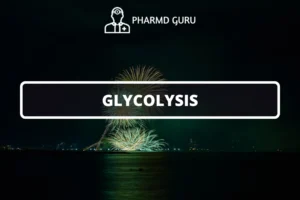The (hexose monophosphate) HMP shunt, also known as the pentose phosphate pathway (PPP), is an important pathway in carbohydrate metabolism. It operates parallel to glycolysis and serves multiple purposes, including the production of NADPH, which is essential for various cellular processes, and the generation of ribose-5-phosphate, a precursor for nucleotide synthesis. This article explores the HMP shunt, highlighting its steps, regulation, significance, and roles in cellular metabolism.
SCROLL DOWN TO THE BOTTOM OF THE PAGE FOR ACTUAL NOTES
Table of Contents
- Introduction to Carbohydrate Metabolism
- Overview of the HMP Shunt
- Steps of the HMP Shunt
- Regulation of the HMP Shunt
- Significance and Roles of the HMP Shunt
1. Introduction to Carbohydrate Metabolism
Carbohydrate metabolism involves the breakdown and utilization of carbohydrates for energy production and the synthesis of essential molecules. Carbohydrates, such as glucose, serve as a primary source of energy and play critical roles in various cellular processes.
2. Overview of the HMP Shunt
The HMP shunt is a pathway that operates alongside glycolysis, primarily occurring in the cytoplasm of cells. It branches off from the glycolytic intermediate glucose-6-phosphate and has two distinct phases: the oxidative phase and the non-oxidative phase. The HMP shunt is highly regulated and plays a vital role in maintaining redox balance, providing reducing power in the form of NADPH, and generating ribose-5-phosphate for nucleotide synthesis.
3. Steps of the HMP Shunt
Oxidative Phase:
- Glucose-6-Phosphate Dehydrogenase (G6PD) Reaction: Glucose-6-phosphate is oxidized by G6PD, resulting in the production of NADPH and the formation of 6-phosphogluconolactone.
- 6-Phosphogluconolactonase Reaction: 6-phosphogluconolactone is hydrolyzed by 6-phosphogluconolactonase, producing 6-phosphogluconate.
- 6-Phosphogluconate Dehydrogenase (6PGD) Reaction: 6-phosphogluconate is further oxidized by 6PGD, generating another molecule of NADPH and yielding ribulose-5-phosphate.
Non-oxidative Phase:
The non-oxidative phase involves a series of reversible reactions that interconvert sugars and produce intermediates for nucleotide synthesis. Some key reactions include the conversion of ribulose-5-phosphate to ribose-5-phosphate and the interconversion of various sugars, such as fructose-6-phosphate and glyceraldehyde-3-phosphate.
4. Regulation of the HMP Shunt
The HMP shunt is regulated at multiple levels to maintain cellular redox balance and meet the demands of nucleotide synthesis. The key regulatory enzyme is glucose-6-phosphate dehydrogenase (G6PD), which is allosterically stimulated by NADP+ and inhibited by NADPH. Additionally, the availability of glucose-6-phosphate and the metabolic needs of the cell influence the flux through the pathway.
5. Significance and Roles of the HMP Shunt
The HMP shunt serves several important roles in cellular metabolism:
- NADPH Production: The primary function of the HMP shunt is to generate NADPH, which is crucial for numerous cellular processes, including antioxidant defense, fatty acid synthesis, and reductive biosynthesis.
- Redox Balance: By providing NADPH, the HMP shunt helps maintain the balance between oxidized and reduced states, contributing to cellular redox homeostasis.
- Ribose-5-Phosphate Production: The HMP shunt generates ribose-5-phosphate, a precursor for nucleotide synthesis. This is particularly important in rapidly dividing cells, such as those in the bone marrow and the immune system.
SCROLL DOWN TO THE BOTTOM OF THE PAGE FOR ACTUAL NOTES




